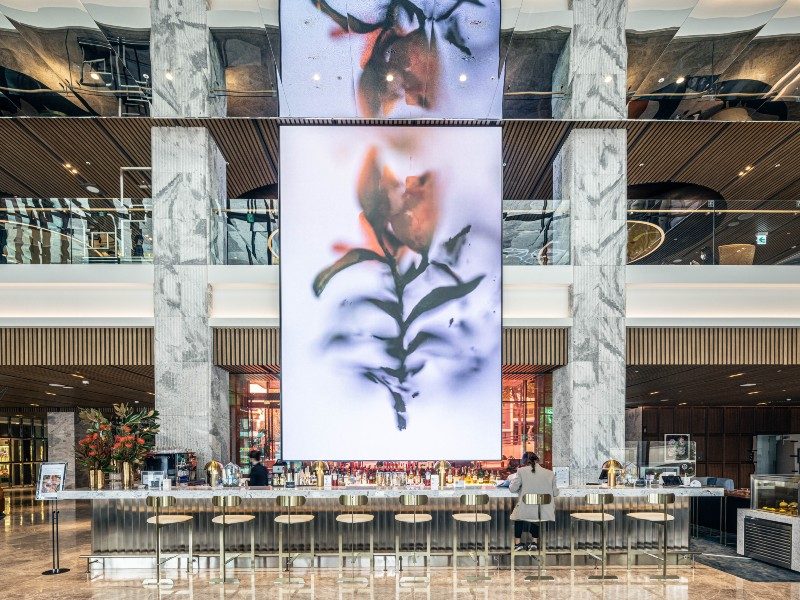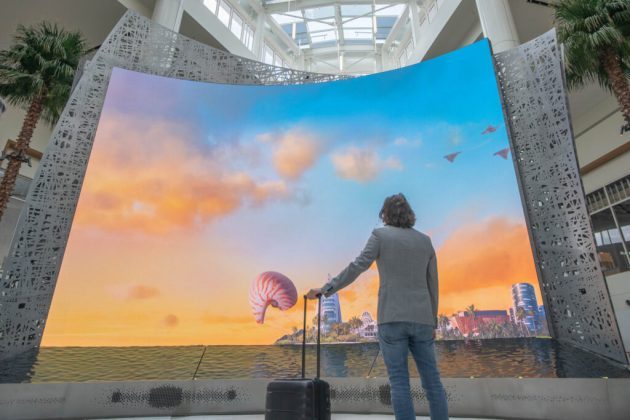We live in a time when companies and individuals are all competing for your attention—usually through social media or endless online updates. Many of us stay glued to our phones, scrolling through content nonstop. Yet if you manage a public-facing venue like a restaurant, hotel lobby, or similar space, you might be looking for a way to draw people’s eyes off their screens and back into the physical surroundings.
A new wave of attention-grabbing approaches is emerging through digital art that merges movement with creative expression. These installations aren’t standard advertisements showcasing your venue’s services; instead, they prompt passersby to pause, watch, and sometimes interact with what’s unfolding in front of them. At the same time, they can incorporate a subtle layer of branding through brand colors or themes that reflect your company’s core values—whether it’s environmentalism or another mission you’re proud to support.
By prioritizing visitor experience, you can turn these pieces into a quiet highlight for staff and guests alike. People who pass through your space each day may start seeing it from a fresh angle, while newcomers find it memorable enough to inspire repeat visits. Not long ago, this kind of digital art might have felt out of place in a professional environment. Today, more property owners see it as a way to infuse their buildings with a dynamic, evolving atmosphere. It’s less about pushing messages and more about encouraging anyone walking by—employees, visitors, or customers—to pause and explore.
The Value of Thoughtful Interaction in Public and Corporate Environments
Many commercial spaces rely on classic framed artwork for a comfortable, appealing atmosphere. That approach can help visitors feel good about the environment, yet adding interactivity shifts the dynamic. Instead of a quick glance at a static piece, people have a reason to pause.
From a neurological perspective, our brains are wired to notice movement or sudden changes—researchers call it an “orienting response.” That brief surge of focus helps break the habit of tuning out routine visuals, so visitors become more aware of what’s around them. Rather than dismissing another still image, they encounter something novel that pulls their attention off their phones and back into the physical setting.
There’s also a subtle psychological benefit. Guests notice when an environment has received extra care, whether that comes through upscale interior design, large murals, custom art, or interactive displays. This additional effort shows that ownership or management invests in the overall atmosphere, which often results in stronger brand loyalty and a closer connection to the company.
But it’s important not to confuse digital art installations with promotional displays. While a flashy display might turn heads for a second, blatant marketing can drive people away instead of engaging them. An evolving piece that gently integrates brand elements appeals to our natural interest in novelty and exploration, leaving a stronger impression than a purely static picture.
By weaving in motion or light changes that don’t scream “promotion,” these installations hold attention while quietly reinforcing brand identity. A Ritz-Carlton lobby might favor a refined, understated form of interactivity, whereas a Disney World hotel could embrace a more playful twist. In either case, the goal is to spark curiosity—an experience that encourages people to linger. If it resonates, it can spark conversations beyond the space itself, reaching potential visitors on social media and beyond.

The Mondrian Hotel in Seoul uses a seasonally changing digital display to engage guests and staff, turning hidden screens into a living art element tied to local culture.
Curation Philosophy Behind Interactive Digital Installations
When people discuss interactive pieces, there’s a tendency to focus on hardware details—like size, resolution, or whether it must be interactive or simply visual. Yet the real core of these installations is the curatorial approach. Any property owner can put a large screen in a lobby, but that alone might not generate the engagement they’re hoping for. What sets a successful digital piece apart from a forgettable gadget is a guiding aesthetic that suits the building’s architecture and the varied individuals who pass through.
Instead of jumping into technical specs, curating a space begins with questions about tone and content. What messages do you want visitors to encounter? Are you reinforcing a brand through color, or showing imagery that aligns with what the organization is known for—like natural ingredients? Should the display feel meditative or playful? Is interactivity more valuable than a static loop? Which gestures or movements are people naturally inclined to make, and who are the primary visitors—employees, families, tourists, or business travelers?
Curators also weigh practical concerns. Building managers might have legitimate worries about noise, brightness, or disturbances. If a piece becomes too distracting, staff may avoid it—or worse, lodge complaints.
These tasks can be daunting if you don’t have a background in art. That’s why a skilled consultant or art advisory team. like atp.art, can help shape an appealing installation that still fits daily operations. They recognize what might work for different audiences and collaborate with stakeholders to accommodate all needs. Curation implies deliberate selection and arrangement of visual or auditory elements into a unified statement. Professionals with a trusted artist network can also commission custom creations if off-the-shelf solutions fall short. They’ll handle planning, production, installation, and even contractual details between the artist and the venue owner.
Above all, a carefully considered design ensures a commercial space is seen as a place where creativity flows naturally in everyday life.

At Orlando International Airport’s Terminal C, large-scale digital artworks evolve with real-time and interactive content, weaving Central Florida’s unique culture into the everyday passenger experience.
Maintaining Relevance and Practical Harmony Over the Long Haul
Once a space adopts an interactive digital installation, the work doesn’t end with turning it on. The piece needs to keep drawing interest. A strong installation can hold people’s attention for years, but only if there’s a plan to refresh the content, adjust any responsive features, and adapt to changes in how the space is being used.
Owners should set up occasional reviews to see whether visitors are pausing and engaging. If feedback shows a dip in interest, small revisions to the visuals or triggers can spark renewed curiosity. The display might switch from a calm setting to something more dynamic at lunchtime, or introduce a new layer each quarter. Those modifications maintain the artwork’s essence while preventing it from feeling stale. Changes in a company’s identity might also prompt these updates. Unlike a static piece that might be replaced entirely—often at high expense—digital installations can be fine-tuned more easily and at a lower cost.
Still, technology can wear down over time. Physical art might remain in place for decades if there’s no reason to swap it out, but digital installations rely on equipment that eventually needs upgrades or repairs. Interactive sensors can degrade, making responses less accurate. As new hardware becomes available, the existing components might start to show their age. Better displays, brighter visuals, or improved sound can re-energize an older piece, so planning for eventual upgrades is a smart move if you want to keep people interested.
Another piece of the long-term equation is how the installation fits broader goals for the building. If the property highlights local culture or hosts seasonal events, the art can shift in color or form to reflect those themes. A district that holds special holiday celebrations might request a slight tweak to the display’s palette or animation so it lines up with the occasion. Curators and consultants can help plan these possibilities well in advance, ensuring the work remains connected to life in the building rather than feeling stuck in a single moment.
Ultimately, maintaining an interactive digital piece isn’t unlike caring for any valuable property element. There’s some technical management involved, but at its core, it’s still an artistic expression meant to spark conversation and curiosity.
——
You might find that interactive digital art doesn’t just decorate a space—it can also open fresh conversations about how people move through and appreciate their surroundings. When a building itself feels like a collaborator rather than just a container, the line between art and daily life starts to blur.
How do you see interactive pieces reshaping your own environment, and what questions or insights come to mind? Let us know in the comments.
